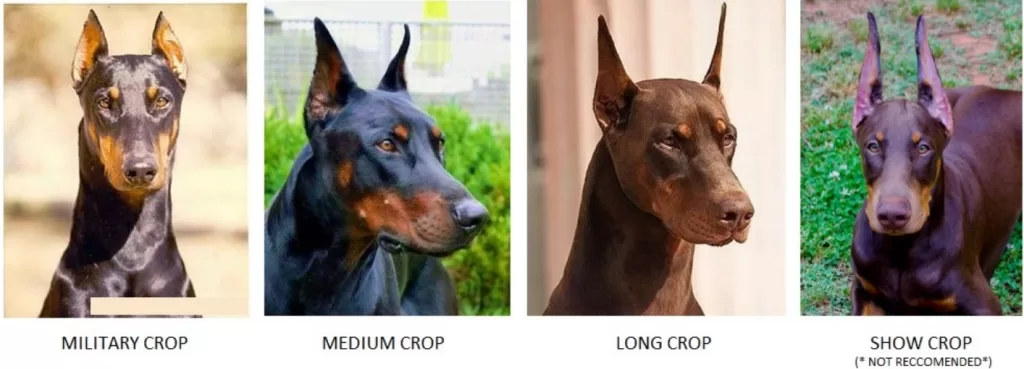Doberman Ear Cropping Styles Chart: For many Doberman Pinscher owners, deciding on an ear cropping style is an important aspect of their dog’s appearance. Ear cropping is a practice in which a dog’s ears are surgically altered to achieve a specific style or look. While opinions on ear cropping can vary, it is essential to approach this topic with an understanding of the different options available.
Table of Contents
In this blog post, we will provide you with a detailed chart outlining various Doberman ear-cropping styles. Each style has its unique characteristics, history, and considerations. However, it is crucial to note that the decision to crop a dog’s ears should be made in consultation with a professional veterinarian, considering the dog’s health, breed standards, and local regulations.
Also Read: Beauceron vs Doberman: 5 Key Differences to differentiate the two breeds
Ear cropping styles available for Doberman

Natural Ears
Natural ears refer to the natural, uncropped shape of a Doberman’s ears. They are smooth, and rounded, and usually sit close to the head. Many Doberman owners now prefer to leave their dog’s ears natural, as it eliminates the need for surgical intervention and allows the ears to develop naturally. Natural ears are becoming more popular and give Dobermans a softer, more natural appearance.
Show crop
The show crop is one of the most common ear-cropping styles seen on Dobermans participating in conformation shows. It involves removing a portion of the ear flap, leaving a triangular-shaped ear that remains erect. Crop length can vary, but is usually long enough to reach the tip of the nose when pulled forward. Show breeding is aimed at enhancing the dog’s alert and attentive expression, as well as conforming to breed standards.
Military or Work Harvest
The military or work crop style is known for its shorter length and more practical appearance. It is often seen in Dobermans used for work purposes, such as police or guard dogs. This short style involves removing a smaller section of the earflap compared to the show cut, resulting in a more proportional and functional look. The military or working crop maintains the ear position upright while providing better protection for the dog during work or physical activities.
Medium crop
The medium crop is a versatile ear-cropping style that falls between the show crop and the military or working crop in terms of length. It involves removing a moderate amount of the ear flap, resulting in ears that are erect but slightly shorter than the show crop. The medium cut offers a balance between aesthetics and functionality, making it a popular choice among Doberman owners who want a moderately trimmed look.
Long harvest
The long crop is characterized by longer ear lengths, extending beyond the length of the show crop. This style creates a striking and elegant look, with the ears standing upright and spreading high above the head. The long crop emphasizes the dog’s regal presence and can be visually stunning. However, it is important to note that the longer length may require extra attention and care to maintain the position of it.
Short harvest
The short crop style involves removing a minimal amount of the ear flap, resulting in erect but relatively short ears. This style provides a practical and functional look while maintaining the distinctive Doberman silhouette. Short, cropped ears are less likely to droop or droop, making them a suitable choice for active Dobermans.
Each ear-cropping style mentioned above has its own look, historical significance, and unique considerations. It is important to consult with a professional veterinarian with experience in ear cropping to discuss which style is best suited for your Doberman based on breed standards, health, and lifestyle. Remember, the decision to crop a dog’s ears should always prioritize the dog’s welfare and comply with local regulations.
Doberman Ear Cropping Styles Chart with Pros and Cons
Here’s a chart outlining the various ear cropping styles available for Dobermans, along with their pros and cons:
| Ear Cropping Style | Appearance | Pros | Cons |
|---|---|---|---|
| Natural Ears | Soft, rounded | – Natural and softer appearance | – Does not conform to breed standards |
| Sit close to the head | – No surgical intervention required | – Can be prone to flopping or tipping over | |
| – Increasing popularity among owners | |||
| Show Crop | Triangular, erect | – Conforms to breed standards | – Requires surgical intervention |
| Enhances alert expression | – Distinctive and elegant appearance | – Longer healing and recovery time | |
| – Suitable for conformation shows | – Potential for complications during the healing process | ||
| Military or Working Crop | Shorter, proportional | – Functional and practical appearance | – Requires surgical intervention |
| Provides protection | – Suitable for working purposes | – Shorter length may limit aesthetic appeal | |
| – Maintains erect ear position | – Potential for complications during the healing process | ||
| Medium Crop | Moderately cropped | – Balance between aesthetics and functionality | – Requires surgical intervention |
| Erect, slightly shorter | – Provides an appealing appearance | – Potential for complications during the healing process | |
| Long Crop | Extended, regal | – Creates an elegant and striking appearance | – Requires additional attention to maintain ear position |
| Ears stand above the head | – Emphasizes the dog’s regal presence | – Potential for complications during the healing process | |
| Short Crop | Short, practical | – Practical and functional appearance | – Requires surgical intervention |
| Ears stand erect | – Suitable for active Dobermans | – Minimal length may limit aesthetic appeal | |
| – Less prone to flopping or tipping over | – Potential for complications during the healing process |
FAQs on Doberman Ear Cropping Styles Chart
Are all Dobermans required to have their ears cropped?
No, ear cropping is a personal choice and not a requirement for all Dobermans. Some owners prefer to leave their dog’s ears natural, while others choose to have them cropped for aesthetic or breed standard reasons.
Can I crop my Doberman’s ears myself?
No, ear cropping should only be performed by a qualified veterinarian who has experience and expertise in the procedure. It is a surgical intervention that requires proper knowledge, skills, and equipment to ensure the safety and well-being of the dog.
What is the best age to crop a Doberman’s ears?
The recommended age for ear cropping varies depending on the veterinarian and the specific circumstances. Generally, it is done between 7 to 12 weeks of age when the puppy’s ears have developed enough to undergo the procedure successfully.
Are there any health risks or complications associated with ear cropping?
Ear cropping, like any surgical procedure, carries inherent risks. Complications such as infection, excessive bleeding, poor wound healing, and anesthesia-related issues can occur. It is essential to choose a reputable veterinarian and follow post-operative care instructions diligently to minimize the risks.
How long does it take for a Doberman’s cropped ears to heal?
The healing time can vary depending on the dog and the specific ear cropping style. Generally, it takes several weeks for the ears to heal fully. During this time, proper aftercare, such as cleaning and bandaging, is necessary to promote healing and prevent complications.
Are there any legal restrictions or regulations regarding ear cropping?
Laws and regulations regarding ear cropping vary by country, state, and even municipality. Some jurisdictions have banned or heavily regulated the practice, while others allow it under certain conditions. It is essential to familiarize yourself with the local laws and regulations before proceeding with ear cropping.
What if I decide not to crop my Doberman’s ears?
Choosing not to crop your Doberman’s ears is a personal decision and is perfectly acceptable. Many Dobermans with natural ears are equally healthy, happy, and loved pets. Natural ears require regular care and cleaning, but they can give your Doberman a unique and natural appearance.
Final Thoughts
In conclusion, our comprehensive guide to Doberman ear cropping styles has given you some valuable insight into the different options available. Ear cropping is a personal choice that should prioritize the health and well-being of your Doberman.
By consulting with a professional veterinarian, considering breed standards, and adhering to local regulations, you can make an informed decision that aligns with your preferences and your dog’s best interests.

